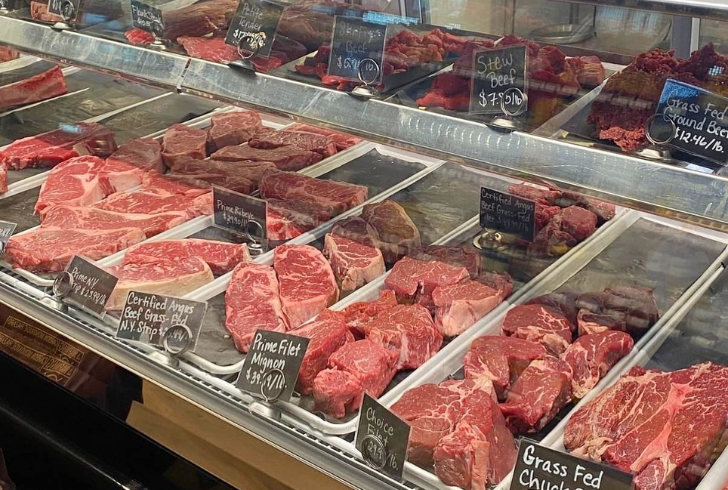
Why Is the Price of Beef Rising in 2024?

Grocery shopping has become a challenging task with prices consistently on the rise. You may recall the unexpected surge in egg prices during the pandemic. Now, it seems beef is the next grocery staple heading towards record highs, with the price of beef rising significantly.
According to the latest Consumer Price Index report by the Bureau of Labor Statistics, beef and veal prices have risen by 7.7% compared to January 2023. Specifically, ground beef is up 5.5%, beef roasts have increased by 6.7%, and beef steaks are up 10.7%.
What’s Driving the Price of Beef Rising?

Instagram | florida_premium_beef | A major reason for the rising price of beef is the limited cattle supply.
A significant factor behind the price of beef rising is the limited supply of cattle. As of early this year, the U.S. had 87.2 million cattle and calves, the lowest starting inventory since 1951, according to Bernt Nelson, an economist at the American Farm Bureau Federation (AFBF). This drop in supply is primarily due to drought conditions and the rising costs of maintaining herds, forcing farmers to reduce their herd sizes.
Key Statistics:
- Ground beef: +5.5%
- Beef roasts: +6.7%
- Beef steaks: +10.7%
Zippy Duvall, President of the AFBF, highlighted the difficulties faced by farmers, stating, “Severe weather, high inflation, and geopolitical uncertainties are straining America’s farmers and ranchers, and families will feel the effects in their grocery bills.”
The Historical Context of Beef Prices
The last significant dip in cattle numbers was in 2014, when the inventory fell to 88.24 million. During that period, beef prices also hit record highs. While prices eased in the following years, they spiked again in 2020 and have been climbing steadily since early 2021.
Current Trends in Beef Prices

Instagram | thesaltybutchermb | Despite the rising trend, beef prices in stores have stayed relatively stable thanks to high production levels.
Interestingly, despite the rising trend, beef prices in stores have been relatively stable due to a high level of beef production. The Kansas State University Meat Demand Monitor found that consumers’ willingness to pay higher prices for beef products increased towards the end of 2023. Wells Fargo reports that consumers are more likely to buy steak when the price is under $10 per pound.
However, price sensitivity remains a crucial factor, with 31% more respondents citing cost as a primary consideration when purchasing protein.
Recent Developments and Future Predictions
Though beef prices dipped slightly by 0.3% since December, and wholesale prices across various cuts have shown a minor decrease in early February, they remain higher than the same period in 2023. The AFBF notes that there is currently enough cattle in the supply chain to prevent sharp price increases immediately. However, this could change in the latter half of 2024 and into 2025.
Anne-Marie Roerink of 210 Analytics predicts that retailers may resort to promotions and discounts on beef products through early 2024 to entice consumers despite higher costs. Courtney Schmidt from Wells Fargo Agri-Food Institute mentions that even with lower supplies, beef will remain the second-highest consumed animal protein, with an estimated consumption of almost 58 pounds per person annually.
What This Means for Consumers

Freepik | The price of beef rising is likely to keep affecting grocery bills.
As we progress through 2024, the potential for record-high beef prices looms large. With supply challenges due to drought and high costs, coupled with rising consumer demand, it’s crucial for shoppers to stay informed and look out for promotions and discounts.
The price of beef rising is a trend that will likely continue impacting grocery bills, making it important to plan purchases wisely and consider alternative protein sources if necessary.
Practical Tips for Managing Beef Purchases
To navigate these potential price increases, consider the following tips:
- Buy in Bulk: Purchasing larger quantities during sales can help save money in the long run.
- Explore Alternatives: Consider other protein sources like chicken, pork, or plant-based options.
- Watch for Promotions: Keep an eye on weekly ads and special offers from your local grocery stores.
- Freeze for Future Use: If you find a good deal, buy extra and freeze it for later use.
By staying informed and strategic with your shopping, you can manage the impact of price of beef rising on your grocery budget. Keep an eye on market trends and adjust your purchasing habits to ensure you get the best value for your money.
More inShopping
-
Will Governor Kugler Push for More Rate Cuts as Inflation Eases?
Federal Reserve Governor Kugler supports the central bank’s recent interest rate cut and plans to advocate for more reductions if inflation...
October 18, 2024 -
Four Seasons Hotel Milano Introduces Personal Styling With Vittoria de Carlo
When it comes to fashion, Milan is unmatched, blending elegance with avant-garde trends. To uncover the heart of Milan’s fashion scene,...
October 9, 2024 -
The Most Successful Female Celebrity Brands
In today’s world, many female celebrities are not just shining in the entertainment industry but also making significant strides as entrepreneurs....
October 1, 2024 -
How to Incorporate Sustainable Outdoor Activities Into Your Travel Adventures
Opting for sustainable outdoor activities may seem challenging at first, but it’s an essential choice for preserving our environment. While integrating...
September 26, 2024 -
Here’s How You Can Get Low Interest on Loans in 2024 & Beyond
How to get a low-interest loan? Well, it is a question many Americans seek an answer to. After all, interest rates...
September 20, 2024 -
How to Buy the Perfect Men’s Belt Online
Selecting the right belt size might seem straightforward, but it can be more nuanced than simply matching it to your pants...
September 12, 2024 -
Why Joey Lawrence and Samantha Cope Parted Ways After 2 Years of Marriage
In a surprising turn of events, Joey Lawrence’s divorce from Samantha Cope has become a topic of widespread discussion. The couple,...
September 2, 2024 -
Must-Visit Tourist Attractions in Brussels
Exploring Fairytale Cities (Bruges and Ghent) One of the best things to do in Brussels is to take a day trip...
August 28, 2024 -
What Is a Write Off and How Companies Use Them?
Understanding the Nuances of Write-Offs Understanding the nuances of what is a write-off is essential for businesses. While the basic concept...
August 23, 2024














You must be logged in to post a comment Login